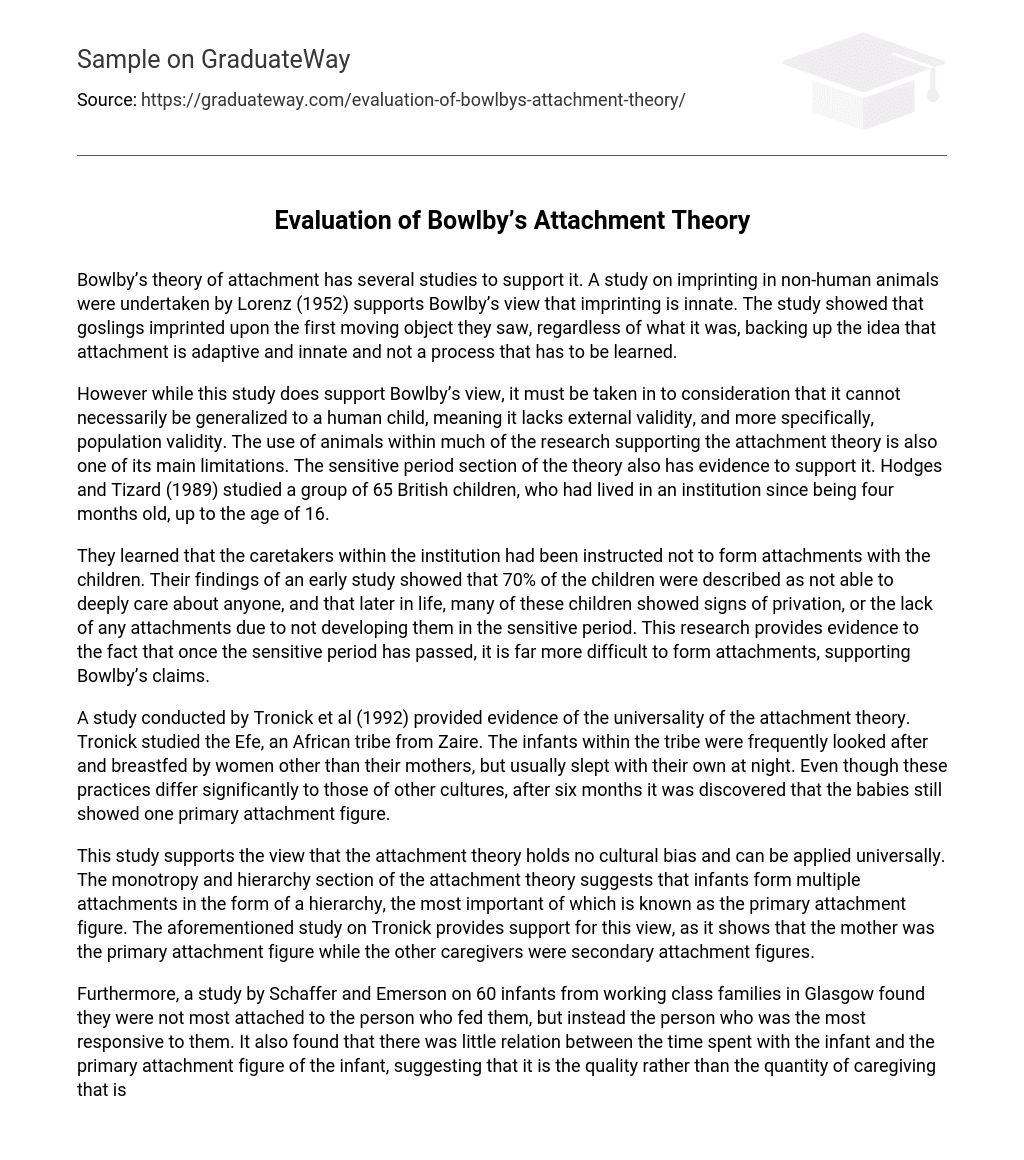Bowlby’s theory of attachment has several studies to support it. A study on imprinting in non-human animals were undertaken by Lorenz (1952) supports Bowlby’s view that imprinting is innate. The study showed that goslings imprinted upon the first moving object they saw, regardless of what it was, backing up the idea that attachment is adaptive and innate and not a process that has to be learned.
However while this study does support Bowlby’s view, it must be taken in to consideration that it cannot necessarily be generalized to a human child, meaning it lacks external validity, and more specifically, population validity. The use of animals within much of the research supporting the attachment theory is also one of its main limitations. The sensitive period section of the theory also has evidence to support it. Hodges and Tizard (1989) studied a group of 65 British children, who had lived in an institution since being four months old, up to the age of 16.
They learned that the caretakers within the institution had been instructed not to form attachments with the children. Their findings of an early study showed that 70% of the children were described as not able to deeply care about anyone, and that later in life, many of these children showed signs of privation, or the lack of any attachments due to not developing them in the sensitive period. This research provides evidence to the fact that once the sensitive period has passed, it is far more difficult to form attachments, supporting Bowlby’s claims.
A study conducted by Tronick et al (1992) provided evidence of the universality of the attachment theory. Tronick studied the Efe, an African tribe from Zaire. The infants within the tribe were frequently looked after and breastfed by women other than their mothers, but usually slept with their own at night. Even though these practices differ significantly to those of other cultures, after six months it was discovered that the babies still showed one primary attachment figure.
This study supports the view that the attachment theory holds no cultural bias and can be applied universally. The monotropy and hierarchy section of the attachment theory suggests that infants form multiple attachments in the form of a hierarchy, the most important of which is known as the primary attachment figure. The aforementioned study on Tronick provides support for this view, as it shows that the mother was the primary attachment figure while the other caregivers were secondary attachment figures.
Furthermore, a study by Schaffer and Emerson on 60 infants from working class families in Glasgow found they were not most attached to the person who fed them, but instead the person who was the most responsive to them. It also found that there was little relation between the time spent with the infant and the primary attachment figure of the infant, suggesting that it is the quality rather than the quantity of caregiving that is most important for strong attachments.
Schaffer and Emerson also observed that the most strongly attached infants has mothers who were able to respond quickly to their needs and provided the most interaction, supporting the theory of caregiver sensitively. Sroufe et al (2005) undertook the Minnesota longitudinal study, following participants from infancy to late adolescence. The study established a link between attachment in early life and later emotional and social behavior, as individuals who were classified as secure in infancy were rated the highest for social competence compared to others.
This supports the continuity hypothesis, the idea that emotionally secure infants go on to be emotionally secure, trusting and socially confident adults. Despite the significant support for the attachment theory, there is also evidence for its limitations. Many psychologists dispute the idea of primary and secondary attachments, and believe that all attachment figures are equally important, in particular Rutter (1995). Within the multiple attachment model, all attachments are integrated into one single working model.
However, while this could be interpreted as showing a limitation of Bowlby’s theory, it could be said that what this model suggests is not too far away from what Bowlby suggested, as within his theory, secondary attachments do contribute to social development but good development requires one person to stand at the top of a hierarchy. There is an alternative explanation to Bowlby’s continually hypothesis, the temperament hypothesis proposed by Kagan (1984). This suggests that an innately trusting and friendly personality could be the prime factor in secure attachments and in forming close adult relationships.
Evidence to support Kagan’s theory was provided by Thomas and Chess (1986), implying that children are born with innate temperamental differences. The three basic infant personality types were identified as easy, difficult and slow-to-warm-up. This in turn was supported by Bokhorst et al (2003), who found that identical twins shared more temperamental features than non-identical twins. The fact that this alternative explanation has significant supporting evidence suggests that the continuity hypothesis may be a limitation of the attachment theory.





